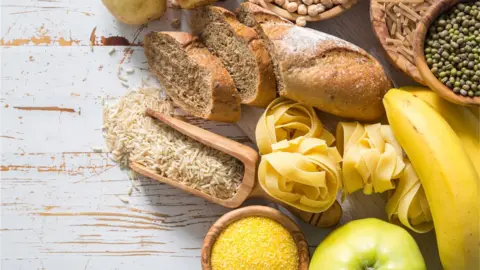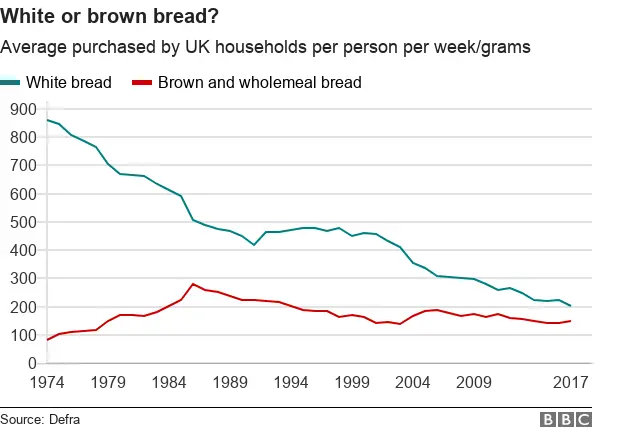The lifesaving food 90% aren’t eating enough of
 Getty Images
Getty ImagesIf I offered you a superfood that would make you live longer, would you be interested?
Naturally it reduces the chances of debilitating heart attacks and strokes as well as life-long diseases such as type-2 diabetes.
And it helps keep your weight, blood pressure and cholesterol levels down.
I should mention it's cheap and widely available in the supermarket.
What is it?
Fibre - it's not the sexiest thing in the world but a major study has been investigating how much fibre we really need to be eating and found there are huge health benefits.
"The evidence is now overwhelming and this is a game-changer that people have to start doing something about it," one of the researchers, Prof John Cummings, tells BBC News.
It's well known for stopping constipation - but its health benefits are much broader than that.
How much fibre do we need?
The researchers, at the University of Otago, in New Zealand, and the University of Dundee say people should be eating a minimum of 25g of fibre per day.
But they call this an "adequate" amount for improving health and say there are benefits for pushing past 30g (1oz).
Is that all?
Well, a banana on its own weighs about 120g but that's not pure fibre. Strip out everything else including all the natural sugars and water, and you're left with only about 3g of fibre.
Most people around the world are eating less than 20g of fibre a day.
And in the UK, fewer than one in 10 adults eats 30g of fibre daily.
On average, women consume about 17g, and men 21g, a day.
 Getty Images
Getty ImagesWhat other foods have more fibre in them?
You find it in fruit and vegetables, some breakfast cereals, breads and pasta that use whole-grains, pulses such as beans, lentils and chickpeas, as well as nuts and seeds.
What does 30g look like?
Elaine Rush, a professor of nutrition at Auckland University of Technology, has put together this example for getting into the 25-30g camp:
- half a cup of rolled oats - 9g fibre | two Weetabix - 3g fibre | a thick slice of brown bread - 2g fibre | a cup of cooked lentils - 4g fibre | a potato cooked with the skin on - 2g fibre | half a cup of chard (or silverbeet in New Zealand) - 1g fibre | a carrot - 3g fibre | an apple with the skin on - 4g fibre
But she says: "It is not easy to increase fibre in the diet."
Prof Cummings agrees. "It's a big change for people," he says. "It's quite a challenge."


Are there any quick and easy tips?
The UK's National Health Service has a page full of them.
They include:
- cooking potatoes with the skin on | swapping white bread, pasta and rice for wholemeal versions | choosing high-fibre breakfast cereals such as porridge oats | chucking some chickpeas, beans or lentils in a curry or over a salad | having nuts or fresh fruit for snacks or dessert | consuming at least five portions of fruit or vegetables each day
What will the benefit be?
Well, after analysing 185 studies and 58 clinical trials, the results are in and have been published in the Lancet medical journal.
It suggests if you shifted 1,000 people from a low fibre diet (less than 15g) to a high-fibre one (25-29g), then it would prevent 13 deaths and six cases of heart disease.
That's during the course of these studies, which tended to follow people for one to two decades.
It also showed lower levels of type-2 diabetes and bowel cancer as well as lower weight, blood pressure and cholesterol levels.
And the more fibre people ate, the better.
What is fibre doing in the body?
There used to be a view that fibre didn't do much at all - that the human body could not digest it and it just sailed through.
But fibre makes us feel full and affects the way fat is absorbed in the small intestine - and things really become interesting in the large intestines, when your gut bacteria get to have their dinner.
The large intestines are home to billions of bacteria - and fibre is their food.
It's a bit like a brewery down there, admittedly one you wouldn't want a pint from, where bacteria are fermenting fibre to make a whole load of chemicals.
This includes short-chain fatty acids, which are absorbed and have effects throughout the body.
"We have this organ set up to digest fibre, which a lot of people just don't use very much," says Prof Cummings.
Why is this relevant now?
The fact fibre and whole-grains and fruit and vegetables are healthy should not come as a surprise.
But there is concern people are turning their back on fibre, with the popularity of low-carb diets.
Prof Nita Forouhi, from the University of Cambridge, says: "We need to take serious note of this study.
"Its findings do imply that, though increasingly popular in the community at large, any dietary regimes that recommend very low-carbohydrate diets should consider the opportunity cost of missing out on fibre from whole-grains.
"This research confirms that fibre and whole-grain intakes are clearly important for longer term health."
The study has been done to help the World Health Organization come up with official guidelines for how much fibre people should be eating to boost health and they are expected next year.
Follow James on Twitter

Analysis from BBC Reality Check
One of the suggested ways of boosting the amount of fibre in your diet is to switch from white bread to brown or wholemeal.
This is what has been happening to sales of those products, based on a succession of government surveys of household spending since 1974.

From the mid-seventies to the mid-eighties, white bread fell while brown and wholemeal rose.
Since then, white bread sales have continued to fall, but brown and wholemeal bread sales have been falling for most of that period, although at a slower rate.
So it looks as if while overall demand for bread has been falling, a higher proportion of bread sold has been higher fibre.
Whole wheat pasta has made less of an impact on sales than higher fibre breads, with a survey for the British Journal of Nutrition finding that pasta accounted for less than 1% of the occasions on which people were consuming whole grains.

